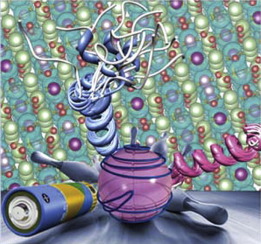当前位置:
X-MOL 学术
›
Prog. Nucl. Magn. Reson. Spectrosc.
›
论文详情
Our official English website, www.x-mol.net, welcomes your feedback! (Note: you will need to create a separate account there.)
Paramagnetic NMR in solution and the solid state
Progress in Nuclear Magnetic Resonance Spectroscopy ( IF 6.1 ) Pub Date : 2019-04-01 , DOI: 10.1016/j.pnmrs.2018.05.001 Andrew J Pell 1 , Guido Pintacuda 2 , Clare P Grey 3
Progress in Nuclear Magnetic Resonance Spectroscopy ( IF 6.1 ) Pub Date : 2019-04-01 , DOI: 10.1016/j.pnmrs.2018.05.001 Andrew J Pell 1 , Guido Pintacuda 2 , Clare P Grey 3
Affiliation

|
The field of paramagnetic NMR has expanded considerably in recent years. This review addresses both the theoretical description of paramagnetic NMR, and the way in which it is currently practised. We provide a review of the theory of the NMR parameters of systems in both solution and the solid state. Here we unify the different languages used by the NMR, EPR, quantum chemistry/DFT, and magnetism communities to provide a comprehensive and coherent theoretical description. We cover the theory of the paramagnetic shift and shift anisotropy in solution both in the traditional formalism in terms of the magnetic susceptibility tensor, and using a more modern formalism employing the relevant EPR parameters, such as are used in first-principles calculations. In addition we examine the theory first in the simple non-relativistic picture, and then in the presence of spin-orbit coupling. These ideas are then extended to a description of the paramagnetic shift in periodic solids, where it is necessary to include the bulk magnetic properties, such as magnetic ordering at low temperatures. The description of the paramagnetic shift is completed by describing the current understanding of such shifts due to lanthanide and actinide ions. We then examine the paramagnetic relaxation enhancement, using a simple model employing a phenomenological picture of the electronic relaxation, and again using a more complex state-of-the-art theory which incorporates electronic relaxation explicitly. An additional important consideration in the solid state is the impact of bulk magnetic susceptibility effects on the form of the spectrum, where we include some ideas from the field of classical electrodynamics. We then continue by describing in detail the solution and solid-state NMR methods that have been deployed in the study of paramagnetic systems in chemistry, biology, and the materials sciences. Finally we describe a number of case studies in paramagnetic NMR that have been specifically chosen to highlight how the theory in part one, and the methods in part two, can be used in practice. The systems chosen include small organometallic complexes in solution, solid battery electrode materials, metalloproteins in both solution and the solid state, systems containing lanthanide ions, and multi-component materials used in pharmaceutical controlled-release formulations that have been doped with paramagnetic species to measure the component domain sizes.
中文翻译:

溶液和固态中的顺磁 NMR
近年来,顺磁 NMR 领域得到了显着扩展。这篇综述既讨论了顺磁 NMR 的理论描述,也讨论了它目前的实践方式。我们回顾了溶液和固态系统的 NMR 参数理论。在这里,我们统一了 NMR、EPR、量子化学/DFT 和磁性社区使用的不同语言,以提供全面和连贯的理论描述。我们涵盖了解决方案中顺磁位移和位移各向异性的理论,包括传统形式主义的磁化率张量,以及使用相关 EPR 参数的更现代形式主义,例如第一性原理计算中使用的。此外,我们首先在简单的非相对论图片中检查理论,然后在存在自旋轨道耦合的情况下。然后将这些想法扩展到对周期性固体中顺磁位移的描述,其中有必要包括体磁特性,例如低温下的磁排序。通过描述目前对由镧系元素和锕系离子引起的此类位移的理解,完成了对顺磁位移的描述。然后,我们使用一个简单的模型来检查顺磁弛豫增强,该模型采用电子弛豫的现象学图片,并再次使用更复杂的最新理论,该理论明确地结合了电子弛豫。固态中的另一个重要考虑因素是体磁化率对光谱形式的影响,我们在其中包含了经典电动力学领域的一些想法。然后,我们继续详细描述已在化学、生物学和材料科学中的顺磁系统研究中部署的溶液和固态 NMR 方法。最后,我们描述了许多顺磁 NMR 案例研究,这些案例研究是专门选择来强调如何在实践中使用第一部分中的理论和第二部分中的方法的。选择的系统包括溶液中的小有机金属配合物、固体电池电极材料、溶液和固态金属蛋白、含有镧系元素离子的系统以及用于药物控释制剂的多组分材料,这些材料已掺杂顺磁性物质以进行测量组件域大小。然后,我们继续详细描述已在化学、生物学和材料科学中的顺磁系统研究中部署的溶液和固态 NMR 方法。最后,我们描述了许多顺磁 NMR 案例研究,这些案例研究是专门选择来强调如何在实践中使用第一部分中的理论和第二部分中的方法的。选择的系统包括溶液中的小有机金属配合物、固体电池电极材料、溶液和固态金属蛋白、含有镧系元素离子的系统以及用于药物控释制剂的多组分材料,这些材料已掺杂顺磁性物质以进行测量组件域大小。然后,我们继续详细描述已在化学、生物学和材料科学中的顺磁系统研究中部署的溶液和固态 NMR 方法。最后,我们描述了许多顺磁 NMR 案例研究,这些案例研究是专门选择来强调如何在实践中使用第一部分中的理论和第二部分中的方法的。选择的系统包括溶液中的小有机金属配合物、固体电池电极材料、溶液和固态金属蛋白、含有镧系元素离子的系统以及用于药物控释制剂的多组分材料,这些材料已掺杂顺磁性物质以进行测量组件域大小。
更新日期:2019-04-01
中文翻译:

溶液和固态中的顺磁 NMR
近年来,顺磁 NMR 领域得到了显着扩展。这篇综述既讨论了顺磁 NMR 的理论描述,也讨论了它目前的实践方式。我们回顾了溶液和固态系统的 NMR 参数理论。在这里,我们统一了 NMR、EPR、量子化学/DFT 和磁性社区使用的不同语言,以提供全面和连贯的理论描述。我们涵盖了解决方案中顺磁位移和位移各向异性的理论,包括传统形式主义的磁化率张量,以及使用相关 EPR 参数的更现代形式主义,例如第一性原理计算中使用的。此外,我们首先在简单的非相对论图片中检查理论,然后在存在自旋轨道耦合的情况下。然后将这些想法扩展到对周期性固体中顺磁位移的描述,其中有必要包括体磁特性,例如低温下的磁排序。通过描述目前对由镧系元素和锕系离子引起的此类位移的理解,完成了对顺磁位移的描述。然后,我们使用一个简单的模型来检查顺磁弛豫增强,该模型采用电子弛豫的现象学图片,并再次使用更复杂的最新理论,该理论明确地结合了电子弛豫。固态中的另一个重要考虑因素是体磁化率对光谱形式的影响,我们在其中包含了经典电动力学领域的一些想法。然后,我们继续详细描述已在化学、生物学和材料科学中的顺磁系统研究中部署的溶液和固态 NMR 方法。最后,我们描述了许多顺磁 NMR 案例研究,这些案例研究是专门选择来强调如何在实践中使用第一部分中的理论和第二部分中的方法的。选择的系统包括溶液中的小有机金属配合物、固体电池电极材料、溶液和固态金属蛋白、含有镧系元素离子的系统以及用于药物控释制剂的多组分材料,这些材料已掺杂顺磁性物质以进行测量组件域大小。然后,我们继续详细描述已在化学、生物学和材料科学中的顺磁系统研究中部署的溶液和固态 NMR 方法。最后,我们描述了许多顺磁 NMR 案例研究,这些案例研究是专门选择来强调如何在实践中使用第一部分中的理论和第二部分中的方法的。选择的系统包括溶液中的小有机金属配合物、固体电池电极材料、溶液和固态金属蛋白、含有镧系元素离子的系统以及用于药物控释制剂的多组分材料,这些材料已掺杂顺磁性物质以进行测量组件域大小。然后,我们继续详细描述已在化学、生物学和材料科学中的顺磁系统研究中部署的溶液和固态 NMR 方法。最后,我们描述了许多顺磁 NMR 案例研究,这些案例研究是专门选择来强调如何在实践中使用第一部分中的理论和第二部分中的方法的。选择的系统包括溶液中的小有机金属配合物、固体电池电极材料、溶液和固态金属蛋白、含有镧系元素离子的系统以及用于药物控释制剂的多组分材料,这些材料已掺杂顺磁性物质以进行测量组件域大小。



























 京公网安备 11010802027423号
京公网安备 11010802027423号